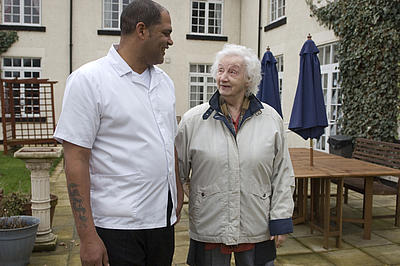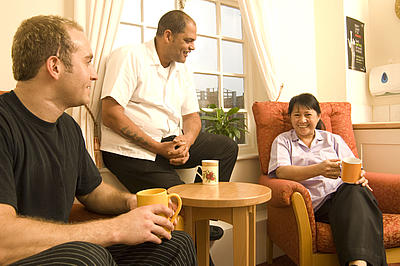Have we as the NHS provided enough support to nursing homes? Or as I heard someone put it the other day have we left nursing homes to become black holes in healthcare?
As a hospital based physician on occasions when admitting a nursing home resident into hospital I am guilty of thinking why has the care home sent them in rather than obtain appropriate support to manage the individual there?
Forgetting that… nursing homes can be isolating places; the trained nursing staff that work in them may be newly qualified, or may have worked in the care home setting for many years and not have much experience or confidence in areas such as palliative care or tissue viability.
Forgetting that… our specialist community nursing teams and services do not provide support into nursing homes as it is seen unnecessary when trained staff are already present.
Forgetting that… the Out-Of-Hours General Practitioner (GP) or paramedic when visiting the home may not have access to information about the patient held either at their GP practice or at the hospital.
Forgetting also that…. the care home staff do not have authority to make appropriate plans of care if these have not already been established by the patient’s GP.
It is estimated that over half of older people in care homes do not have access to all the services and support they require from the NHS (British Geriatrics Society, 2012). A recent case study in East Berkshire’s care homes identified that some GPs do not see improvement in care homes as their responsibility and question the need to fund such initiatives (NHS Improving Quality, 2014). Can we blame them when they are already overworked and under pressure in so many areas?

Previously, little NHS investment has gone into improving care within nursing home settings, they are private organisations after all. However, this reasoning to not provide help and support neglects to recognise that nursing homes look after our most vulnerable and at risk older people. Recent research has found that care home residents have 40 to 50 per cent more emergency admissions and A&E attendances than the general population aged 75 and over (Smith, 2015). Now, due to the Better Care fund, there is a drive to reduce avoidable admissions to hospitals and a variety of pilot schemes have been set up across the country, some involving providing support into nursing homes. But, for a group of services where an estimated 325,000 older people in England reside, it feels like we’re late in the game.
One particularly memorable occasion I was trying to discharge a patient back to their nursing home for palliative end of life care, it was established that their needs were too complex for the nursing home to deal with. Instead of the community team being able to support the nursing home to meet the patient’s needs (they would have been able to provide support in the patients “own home”) the family had to find a new nursing home. What made this even sadder was that he had been living in the same nursing home as his wife who had dementia and it was felt that she would be unable to visit him elsewhere.

Are we not willing to accept that a nursing home can be a person’s “home”? Or that services that this individual needs should be made available to them in the setting that they live? This attitude is changing with many more services being made available to nursing homes, but a lot more can be done.
The Yorkshire and Humber Improvement Academy is hosting the Yorkshire and Humber Patient Safety Collaborative. Leadership for patient safety, and reducing falls are priority areas for all Patient Safety Collaboratives (NHS England, 2015). In Yorkshire and Humber we are striving to change this and include care homes through Clinical Commissioning Groups (CCGs) and GPs. One project already established is focusing on medicines reconciliation in care homes. Another is preventing falls – adapting an intervention that has been successful in hospital settings to be useful in care home settings.
This may seem like a small place to start, but as quality and safety of care improves within our community and care home settings this should have positive repercussions on the rest of the system and hopefully free up the time required providing this work with on-going support. If services, approaches and ambitions for patient care can be joined up then what could we achieve for those individuals who have already sown and paid into our lives? We owe it to our elderly population to make sure that we provide the right care, in the right place and at the right time, even if this comes with a cost.
References
Age UK (2015) Later Life in the United Kingdom [Online] Available at: http://www.ageuk.org.uk/Documents/EN-GB/Factsheets/Later_Life_UK_factsheet.pdf?dtrk=true (Accessed 12 March 2015).
British Geriatrics Society (2012) Failing the Frail: A Chaotic Approach to Commissioning Healthcare Services for Care Homes [Online] Available at: https://britishgeriatricssociety.wordpress.com/2012/03/19/failing-the-frail-a-chaotic-approach-to-commissioning-healthcare-services-for-care-homes/ (Accessed 13 March 2015).
NHS England (2015) Priority areas for Patient Safety Collaboratives [Online] Available at: http://www.england.nhs.uk/ourwork/patientsafety/collaboratives/priority-areas/ (Accessed 13 March 2015).
NHS Improving Quality (2014) Case Studies [Online] Available at: http://www.nhsiq.nhs.uk/news-events/news/ext-oct-2014-10.aspx#sthash.dFOuucih.dpuf (Accessed 13 March 2015).
Smith, P., Sherlaw-Johnson, C., Ariti, C., Bardsley, M. (2015) Focus on: Hospital admissions from care homes, The Health Foundation and Nuffield Trust [Online] Available at: http://www.health.org.uk/public/cms/75/76/313/5435/QualityWatch%20-%20Hospital%20admissions%20from%20care%20homes_full.pdf?realName=3DsYKd.pdf (Accessed 13 March 2015).